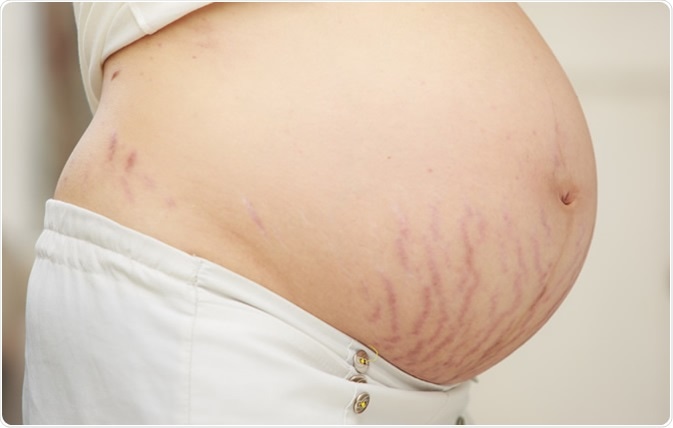Pregnancy
How To Prevent Stretch Marks During Pregnancy

Last Updated on November 3, 2025 by Joshua Isibor
Before we can effectively prevent stretch marks during pregnancy we have to first find out what causes stretch marks during pregnancy.
Some new moms-to-be surprisingly love their stretch marks, to them proudly it is a sign of motherhood. While others don’t want to ever see or talk about it, for them, they are just pregnancy stretch marks and should be gotten rid of immediately.
When do stretch marks start during pregnancy?
Stretch marks become noticeable when you’re somewhere around 13 weeks to 21 weeks pregnant. Up to 90 per cent of all expecting women get these marks in different colours; red, white, brown, and purple. It is likely noticeable across your belly, butt, thighs, hips, or breasts.
What causes stretch marks during pregnancy?
Stretch marks are tiny tears or lines in the uppermost layers of the skin tissue, it occurs when your skin is stretched beyond its limits. Genetics also plays a major role in getting stretch marks during pregnancy. If your mom has it you’re likely going to have it too. Rapid weight gain during pregnancy can also make you more prone to getting stretch marks. And lighter-skinned women are more prone to getting stretch marks than darker-skinned (since it is usually more noticeable on lighter skin).
How to prevent stretch marks During Pregnancy
While there is no way to guarantee that a person will not develop stretch marks during pregnancy, the following tips may help reduce the likelihood of their appearance;
1. Control your weight
One of the most helpful things you can do to prevent stretch marks especially when you’re pregnant is to maintain a healthy weight. Stretch marks can happen when your skin stretches beyond its elastic limits. Some people also notice stretch marks after rapid weight loss. Other people, like bodybuilders, notice them after big gains from working out or using steroids.
Therefore working to control your body change, especially its weight gain from happening too quickly may be a good idea. Eat a healthy diet and exercise to help you take control of your weight.
2. Stay hydrated
Drinking enough water may help keep your skin stay hydrated and supple. Soft skin doesn’t tend to develop stretch marks as much as dry skin does. Drinking caffeinated beverages, like coffee, may increase your risk of developing stretch marks. So instead of coffee take a lot of fruit drinks and herbal tea.
3. Eat a nutrient-rich diet
Stretch marks may also occur if you lack nutrition in certain areas. Eating foods that boost skin health may help. Make sure your diet includes foods rich in:
- vitamin C
- vitamin D
- vitamin E
- zinc
- Omega-3 fatty acids
One way to get plenty of nutrients from meals is to eat unprocessed foods such as sardines, walnuts, soybeans, eggs, veggies, etc
4. Include vitamin C in your diet
Vitamin C is a collagen booster. Collagen plays a role in keeping your skin strong and elastic. It helps reduce the appearance of wrinkles, thus it can also be important for preventing stretch marks. Vitamin C can be found in many fruits and vegetables. Citrus fruits, such as oranges and lemons, are especially good sources of vitamin C. There are also some vitamin C supplements in the pharmacy too.
5. Get vitamin D
One study found a correlation between low levels of vitamin D and the incidence of stretch marks. More research is needed, but results suggest that maintaining healthy levels of vitamin D may reduce your risk of stretch marks.
The easiest way to get vitamin D is through exposure to the sun. However, too much sun exposure can be risky. You can also get vitamin D from several fruits too. The vitamin is also commonly added to bread, cereal, and dairy products like milk or yoghurt.
6. Eat foods rich in zinc
Zinc is an important nutrient for skin health. It helps reduce inflammation and plays a role in the wound-healing process. There is very little evidence to date of a connection between zinc and stretch marks, but including zinc-rich foods in your diet, such as nuts and fish, may help keep your skin healthy.
7. Use a moisturizer
Moisturizing the skin regularly may help prevent stretch marks.
Keeping the skin supple may help reduce the risk of getting stretch marks during pregnancy. Moisturizing with Cocoa butter certainly won’t hurt, though no stretch mark cream is a miracle cream. If nothing else, moisturizing daily will help with the dryness and itchy skin related to pregnancy.
8. Limit or avoid steroid creams for itching
Steroid creams or corticosteroids, which usually contain cortisone, may weaken the skin’s collagen and result in stretch marks. However, people concerned about this should speak to a doctor before discontinuing them.
If a person must use creams containing cortisone, it is best to use them only for as long as necessary before switching to a milder cream.
8. Get regular exercise
Exercising regularly can help a person manage their weight during pregnancy. Remaining at a healthy weight can reduce the risk of excessive skin stretching.
Exercise also increases blood flow to the skin, which results in the skin rebuilding itself.
9. Wear sunscreen and avoid direct sun
The sun’s ultraviolet (UV) rays damage the skin, especially its collagen and elastin, which can make stretch marks more likely to form.
Pregnant people should seek shade, wear UV-protective clothing, and apply sunscreen daily. It is essential to allow the sunscreen to absorb for 30 minutes before sun exposure and to reapply it at least every 2 hours while spending time in the sun.
10. Avoid smoking
Smoking reduces blood flow to the skin, which deprives it of the oxygen it needs to repair itself. In addition, smoking depletes nutrients in the body that the skin needs to stay healthy.
Smoking also releases damaging free radicals, which can break down the collagen and elastin fibres in the skin.
A healthy lifestyle can help keep the skin looking supple and smooth and may help prevent stretch marks.
However, genetics also contribute to a person’s likelihood of developing stretch marks, so it may not be possible for everyone to prevent them. However, following these quick tips might go a long way to helping your skin and overall health.
ALSO, READ 14 Possible Benefits Of Drinking Coconut Water In Pregnancy
Originally posted 2020-11-03 09:30:01.

-

 Text Messages2 years ago
Text Messages2 years agoBEST LOVE CONFESSION MESSAGES FOR HER OR HIM
-

 Health2 months ago
Health2 months ago5 Unknown Ways To Maintain Skin Health
-

 Sex Education3 days ago
Sex Education3 days ago10 Simple Hack to Make a Girl Send Her Nudes
-

 Text Messages2 years ago
Text Messages2 years agoHappy Birthday Cousin, wishes and messages
-

 Text Messages2 years ago
Text Messages2 years agoHeart Touching RIP Uncle Quotes
-

 Uncategorized1 month ago
Uncategorized1 month agoHOW TO KISS A BOY FOR THE FIRST TIME
-

 Text Messages2 years ago
Text Messages2 years agoBest Good Luck Wishes Before and After Surgery, for Family and Friends
-

 Text Messages2 years ago
Text Messages2 years agoFreaky and Dirty Paragraphs For Him Copy And Paste Yahoo













